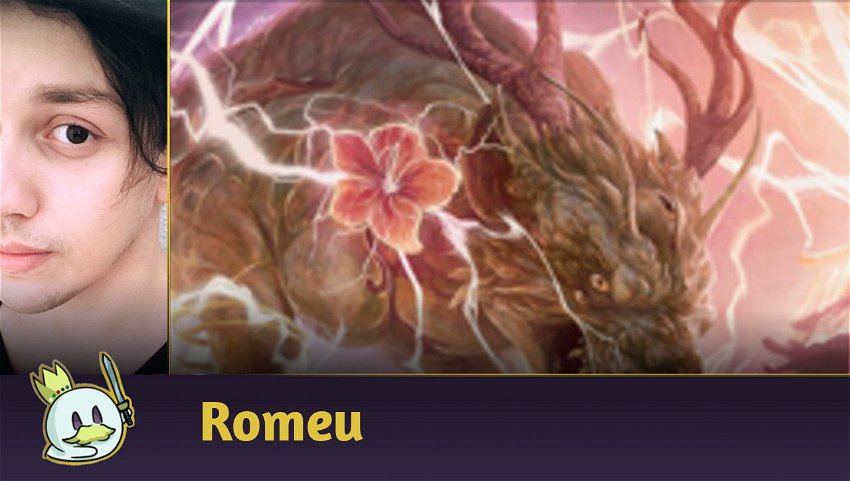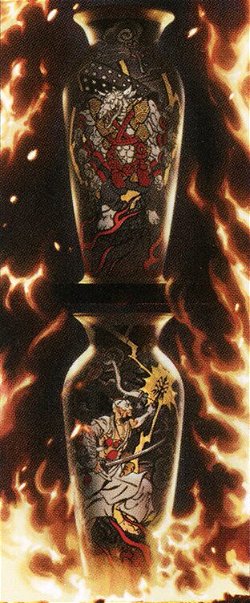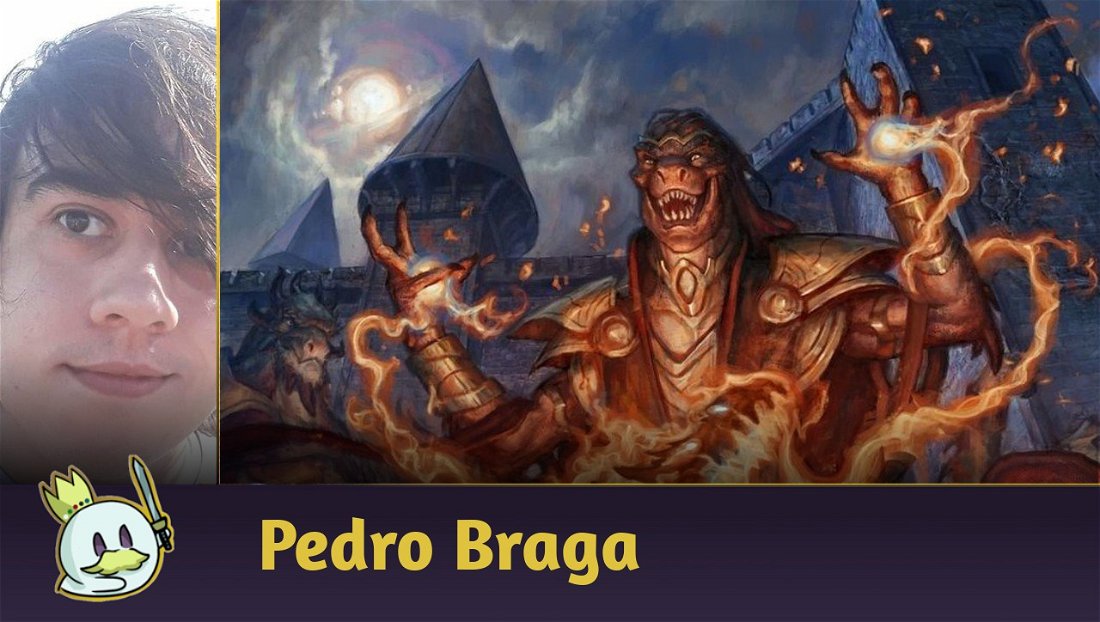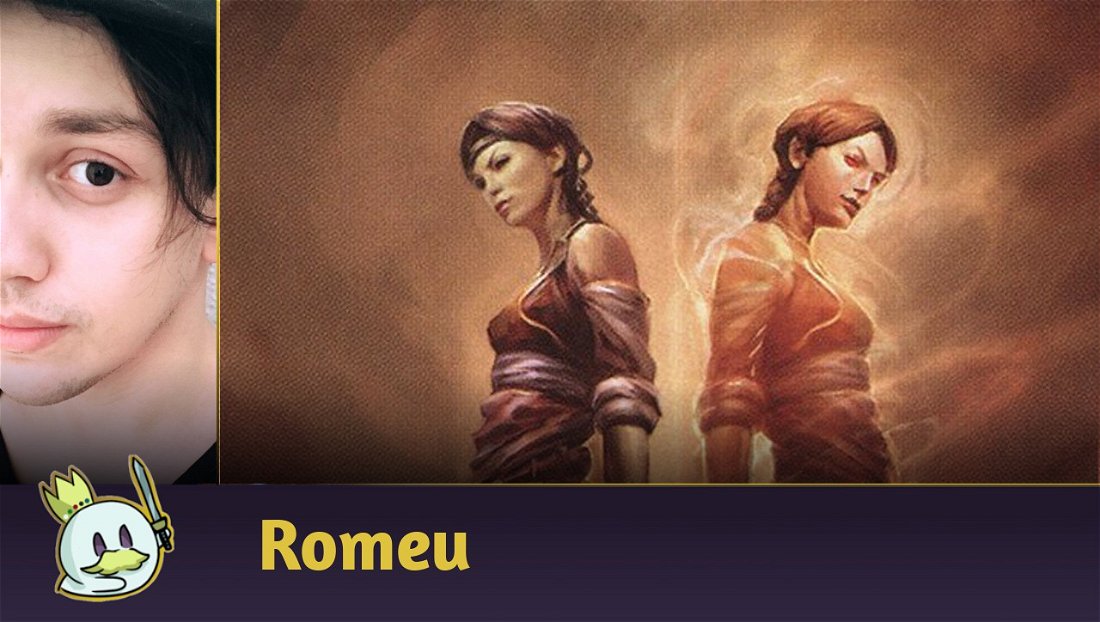One of the main differences in my experience of playing Magic in tabletop or on a digital platform is my time management: when I go to a tournament, I know that each round will be around 50 minutes and even if I finish my match in turn 3 in both games, I still have to wait for all players to post their results before starting another round.
And while there are advantages to ending my round early, I'm not necessarily rewarded for it — So, in a tabletop tournament, my deck preference tends to be the one that best rewards my decisions, which usually leads me to attrition-oriented archetypes like Tempo or Midrange.
When we talk about digital platforms like Magic Arena or Magic Online, we can manage our time based on how fast we win or lose our games, and that really matters when we're grinding or trying to climb the ranked ladder, the less time our matches last, the more opponents we face and the more wins or losses we accumulate — in Magic Online, for example, this means more trophies and chests in Leagues for less time — and for that reason, I tend to opt for fast archetypes that fit the Aggro or Combo categories that provide good results.
Today, Standard is in a Metagame where most decks seek to play for value, making it necessary to have a strategy that bets on synergy and speed to catch them: Boros Aggro.
The Decklist
The list I've been using basically follows the same pattern as what you usually find most of the time because, honestly, there's no need to tinker with the slots too much and the deck is extremely consistent with this combination.
Boros Aggro has a similar proposal to Mono White, but while the monocolored version bets on punishing the opponent in the early game with taxing effects like Thalia, Guardian of Thraben and Elite Spellbinder to then stay ahead mid-game with The Wandering Emperor and Legion Angel, the two-color version revolves around the interaction between +1/+1 counters and Thundering Raiju with good creatures on their own, while resorting to direct damage spells to speed up the clock and/or interact with opposing creatures.
Maindeck

As with all aggressive archetypes, we need to establish a growing curve of our threats so that each one puts more pressure on the opponent, creating a “snowball” effect.
Our one-drops include Hopeful Initiate, which grows when attacking alongside virtually any of our threats, and also doubles in utility to deal with problematic permanents like Fable of the Mirror-Breaker or The Meathook Massacre, and I point out that its ability can be activated by removing counters from any creature, not just itself.
Kumano Faces Kakkazan, or the Goblin Guide that Standard and Pioneer deserves, increases the pressure you can put on the opponent from the second turn and hardly becomes a bad topdeck while you are ahead in the game, and its other side is the only one available in Standard that impacts the game the moment it returns to the battlefield as a 2/2 Haste.

The turn 2 sequel features Luminarch Aspirant, a staple of aggressive Standard archetypes and one of the biggest long-term threats of white decks.
We also have Bloodthirsty Adversary, which should be commonly played on turn 2, as an early-game creature with haste, but can double as a 2-for-1 in late-game when getting stronger and still casting a removal or burn from your graveyard.

Our 3-drops directly interact with the Day/Night mechanic and punish your opponents for being too reactive, with Brutal Cathar functioning as a pseudo-removal that turns into a threat overnight, and Sunrise Cavalier which will commonly be a 4/4 creature with Trample and Haste for three mana when it enters the battlefield, but which also serves to grow another creature, so they don't die in combat, or to amplify the amount of modified creatures in play — something important for the next card on the list.

Thundering Raiju is our top corner, and anyone who played with Hellrider in the Innistrad-Ravnica era remembers the headache of not dealing with it the turn the devil came into play.
On this list, one of Neon Dynasty's most aggressive four-drops basically serves the same purpose and utility as, normally, most of your creatures will be modified when it comes into play, and a 4/4 for 4 mana (considering that you use the first Raiju trigger on itself) that already enters attacking normally will make it the magnet of the opponent's removals if there are any.

Our interactions package has spells that double in functions like direct damage and removal in the same spell: Play With Fire is the upgraded Shock and helps to pull the last points of damage and filter, if only a little, our top — helping to find the right creature or spell to end the game.
Roil Eruption is the closest we have to Lightning Strike in Standard today, and while its Sorcery-Speed is an issue, it's not like we have better options for those slots. An important point to point out is that the Kicker cost of this spell is very high, so don't waste time saving it to try to deal 5 damage to the opponent because you will hardly succeed unless the game goes on for too long.
Finally, we have Valorous Stance which operates as a protection spell for your top creatures and removal for some of the main threats in Standard today — Goldspan Dragon, Hinata, Dawn-Crowned, Old-Growth Troll, Raffine, Scheming Seer, plus any creatures that overgrow in Naya Runes, are good targets for this spell — and with Mono-Green growing up lately and the adaptation of the other archetypes to deal with our deck, I decided to remove a Play with Fire to add a second copy on Maindeck.

As usual in Standard today, we resort to a few copies of utility lands like the Channel Lands and Manlands, allowing us to mitigate a potential flood by always acting even with an empty hand.
Sideboard

During post-side games against various decks, you need options that delay their plans to advance yours, and luckily, there's no shortage of options in the Mono-White base, with Thalia, Guardian of Thraben and Elite Spellbinder.

Kami's Flare is the extra removal needed for other creature-based games such as Mono-Green, Mono-White, the mirror, and Grixis Vampires.
My Sideboard removals package also had a second copy of Valorous Stance, but I moved it to the maindeck in favor of a more important element for attrition matchups: Showdown of the Skalds.

Angelfire Ignition is a great option in games where you need to be faster than your opponent and/or in games where they don't have many interactions - the combination of Trample, Lifelink and Vigilance, plus the power boost can turn many games on your favor, and being able to cast it separately two turns in a row puts any Aggro behind in a race.
Showdown of the Skalds is a little used sideboard spell these days, but it still makes a lot of sense to include a copy or two in the list as it serves to grind basically any matchup since, in Games 2 and 3, they tend to be slower as both players put more answers in, and the “draw 4” and pump of later turns will usually put your opponent far behind when they have spent their resources.
If you prefer not to run the enchantment, you can add a third Angelfire Ignition and an extra copy of Valorous Stance.
Mulligan and Stances
Mulligan

Despite the example above, the truth is that I don't think there is specifically a "perfect hand" with Boros Aggro because it is very redundant in its options and as long as you have a proactive hand that allows you to sequence threats well enough, you will have the elements needed to establish the initial pressure and your topdeck will be your main asset — which it usually rewards you with since, as mentioned, this list is extremely redundant.
This changes in post-sideboard games because you will usually have to adapt better to the game and will likely need an interaction piece or two with your opponent in your starting hand, but remember that you are always the beatdown and keeping reactive hands and/or with few or no creatures is the likely key to your defeat.
Although it seems kind of obvious, you should also avoid hands that have too many 3-mana or higher threats regardless of how good they are because your game is based on pressuring on your opponent, and the lack of bodies on the board in the first few turns makes a huge difference.
Stances
Since we're piloting an Aggro deck without much flexibility with stances, our goal is to pressure the opponent every turn, whether that's casting creatures on consecutive turns, or removing blockers and other problematic threats with our spells while we keep attacking — putting yourself too behind will hardly be what you want to do, especially in pre-sideboard games.
Post-Sideboard, we need to think better about which posture we should adopt, but we still assume that we are the beatdown in Early-Game, with the difference that we must understand what we are playing against and in relation to which opposing interactions we have to play around.
In a matchup against another Aggro, for example, we will possibly need to spend a few turns without attacking to avoid compromising our board position while we don't have lethal damage and/or to avoid any combat trick that could put us at a disadvantage, in addition to using our spells as removals.
Against a Control or Midrange, we must consider which interaction pieces may be in the opponent's hand and seek to sequence our threats according to how expendable and/or impactful they are. You usually want to avoid, for example, casting Elite Spellbinder on turn 3 if your opponent has two untapped lands and will possibly have a Make Disappear, or compromising your position too much and emptying your hand only to see them cast The Meathook Massacre and destroy all your creatures on the next turn.
In the end, despite being exceptionally proactive, Boros Aggro isn't just about casting your creatures and attacking every turn — you need to assess your position and decipher what might come from the other side, especially in Games 2 and 3. In Game 1, I usually tend to take risks, as our deck is made up of trying to win the match as quickly as possible, but you'll see how much our stance changes in each game in the Sideboard guide.
Tips & Tricks
• The Day/Night cycle is extremely tricky to follow if you don't pay attention, so remember to check this condition before casting Brutal Cathar, as you'll probably prefer to exile an opponent's creature rather than just having a 3/3 with First Strike for three mana.
• On the other hand, our list usually has no problem manipulating the Day and Night cycle to take advantage of Sunrise Cavalier's ability when we're in a favorable board— stop casting spells for a turn when we're ahead and prioritizing activating a manland or channeling Sokenzan can be helpful in growing your threats.
• Kumano Faces Kakkazan has the ability to exile permanents that have taken damage from a source you control, relevant when we want to permanently deal with Tenacious Underdog.
• Unless I need to make another attacking creature survive combat, I usually use the first Thundering Raiju trigger on itself to protect it from Roil Eruption, Strangle or Abrade, but if your opponent is running white, it may be preferable to keep it as a 3/3 to not make it a legal target for Valorous Stance.
• Angelfire Ignition gives Haste to target creature. So, you can use it to catch an opponent off guard and deal an insane amount of damage with a creature they don't respect — This works incredibly well with Brutal Cathar and Elite Spellbinder.
• When in doubt as to which manland to activate on an empty board, consider whether your opponent has the means to deal with Den of the Bugbear at Instant-Speed. If so, you probably should activate Cave of the Frost Dragon, unless a flying threat is more important, as is often the case in an Aggro mirror.
• Finally, Showdown of the Skalds is usually the last spell you want to cast from your hand because it will help you recover resources on turn 5 or 6 onwards, where you get to play and cast most of the revealed spells on the next turn.
Sideboard Guide
Jeskai Hinata
IN:

OUT:

This game revolves around two goals: preventing Hinata, Dawn-Crowned from being on the battlefield, and delaying Magma Opus as long as possible — two goals that we aren't able to do well in the game 1, and therefore we need to race.
Post-Sideboard, we remove our burns as they aren't good at interacting with their threats, and we've added every possible element to delay an archetype geared towards non-creature spells, with Thalia, Guardian of Thraben and Elite Spellbinder, essentially punishing our opponents' removals and other bombs as we try to advance our game through combat.
Both Roil Eruption and Play with Fire are pretty much useless in this game, and the absence of relevant Instants and Sorceries makes Bloodthirsty Adversary worse, so I opt to remove two copies of it.
Grixis Vampires
IN:

OUT:

Game 1 against Vampires is kind of tricky because depending on the version they have numerous removals and their creatures are better on their own than ours, whereas Voltage Surge deals with basically any of our threats, and here we need a stance closer to the midrange where we kill their creatures with our burns and advance our position by attacking them.
Post-Sideboard, Brutal Cathar gets worse as they add more removals and Valorous Stance has few major targets on the other side of the table, so we continue to bet on a midrange game where our removals trade well with theirs while Showdown of the Skalds allows us to stay ahead in Card Advantage.
Our worst enemy in this game is Evelyn, the Covetous, as she basically blocks our creatures pretty well and turns any Vampire into a value engine, and her ability lets them cast Instants exiled with her on our turn, plus the potential to steal important threats like Sunrise Cavalier.
Mono-Green Aggro
IN:

OUT:

The matchup against Mono-Green is especially bad in Game 1, and we need to take a stance completely contrary to what the list proposes to do after the Sideboard - making us a kind of reactive Midrange instead of trying to go for aggression because everything on the other side is a problem: Invoke the Ancients creates two tokens that are hell to deal with, Old-Growth Troll is only answered by Brutal Cathar or Valorous Stance, and Esika's Chariot is a terrible snowball if they untap with it for one turn, not to mention Ranger Class that cuts the reach of our removals.
As a result, we've removed many threats and pieces that work well together but aren't relevant on their own in this particular game, while adding more removals, card advantage, and the combination that normally wins the game: Elite Spellbinder, which works incredibly well in terms of delaying some bombs and their only blocker will be the Invoke the Ancients token, and Angelfire Ignition to turn the tables in our favor.
However, the opponent probably also knows that our main threat is Elite Spellbinder and will most likely store removals like Blizzard Brawl and Inscription of Abundance to deal with it.
Esper Midrange
IN:

OUT:

The matchup against Esper is difficult as we don't have much to do against it and our best route is to be the aggressor in every game and pressure them at every turn, avoiding giving time to solve all our creatures and keep our Valorous Stances to destroy Raffine, Scheming Seer.
Due to the lack of options, my post-sideboard options are to remove Roil Eruption which, despite serving as a Burn and removal, we need to interact with several threats at Instant-Speed, where Kami's Flare excels at and can still do some extra damage while removing other problematic threats like The Wandering Emperor, and also look to have more attrition with Showdown of the Skalds while removing Hopeful Initiate which, despite removing Wedding Announcement and The Meathook Massacre, is a bad topdeck and doesn't really help our posture here.
Boros Aggro
IN:

OUT:

Normally, the Mirror Match is based on both players looking to keep the other's board clean while attacking with their creatures and our second copy of Valorous Stance puts us in an awkward position because it can save one of our main threats while not being as helpful in removing something from the opponent, despite being our main answer against Thundering Raiju or Sunrise Cavalier.
Post-Sideboard, I choose to remove Valorous Stance as the top threats with the potential to become 4/4 can be dealt with a Kami's Flare before their triggers resolve, while Kumano Faces Kakkazan doesn't do enough to be justified in this matchup and Thundering Raiju generates a mana disadvantage against their Kami's Flare.
Our key cards in this game are Angelfire Ignition for reasons already mentioned, but we need to be careful when casting it as our opponent might respond with a removal, while we also need to always keep a removal to deal with their copy of this spell — and our main asset turns out to be Showdown of the Skalds, which will commonly give us more reach than versions that choose not to run copies of this enchantment on the Sideboard.
Don't be afraid to exchange your creatures with your opponent's to keep their board empty if you have more resources, especially on the Draw, where they'll usually start pressuring you from turn 2 or 3.
Conclusion
Boros Aggro is one of the best archetypes of Standard today, as it snags a Metagame that seeks slower, value-oriented games by playing under them in the first game, while still managing to adapt to the most diverse situations with its Sideboard.
It is one of the best options both for Best of 1, where its speed is extremely punishing for our opponents, and for the Best of 3, where it shows excellent results in the most varied events in addition to being a great option for those who prefer to close matches in a few turns and especially for those who enjoy Magic Arena on their mobile devices.
Thanks for reading!













— Comments 0
, Reactions 1
Be the first to comment